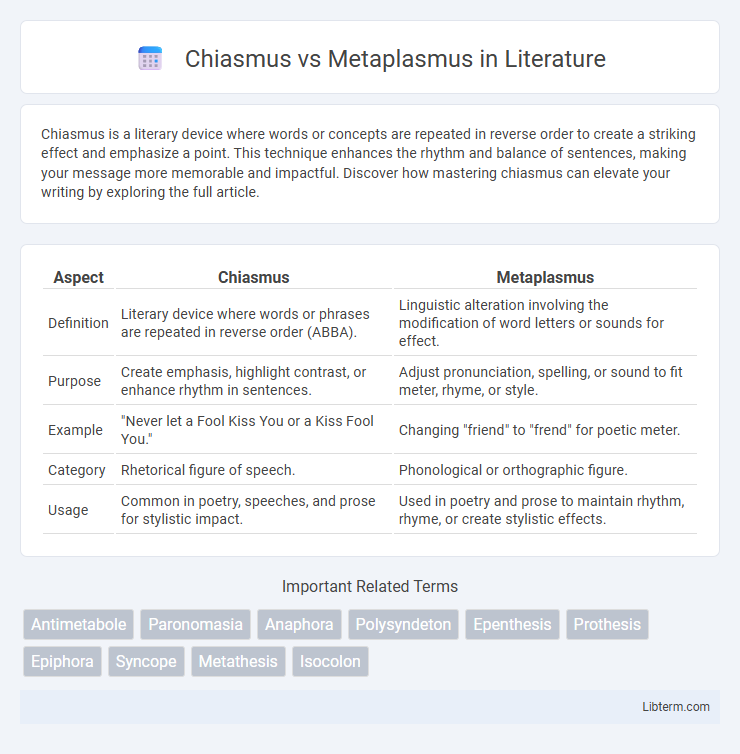Chiasmus is a literary device where words or concepts are repeated in reverse order to create a striking effect and emphasize a point. This technique enhances the rhythm and balance of sentences, making your message more memorable and impactful. Discover how mastering chiasmus can elevate your writing by exploring the full article.
Table of Comparison
| Aspect | Chiasmus | Metaplasmus |
|---|---|---|
| Definition | Literary device where words or phrases are repeated in reverse order (ABBA). | Linguistic alteration involving the modification of word letters or sounds for effect. |
| Purpose | Create emphasis, highlight contrast, or enhance rhythm in sentences. | Adjust pronunciation, spelling, or sound to fit meter, rhyme, or style. |
| Example | "Never let a Fool Kiss You or a Kiss Fool You." | Changing "friend" to "frend" for poetic meter. |
| Category | Rhetorical figure of speech. | Phonological or orthographic figure. |
| Usage | Common in poetry, speeches, and prose for stylistic impact. | Used in poetry and prose to maintain rhythm, rhyme, or create stylistic effects. |
Introduction to Chiasmus and Metaplasmus
Chiasmus is a rhetorical device featuring the reversal of grammatical structures in successive phrases, enhancing emphasis through balanced symmetry. Metaplasmus involves the intentional alteration of word forms, such as adding, omitting, or substituting letters, to achieve stylistic or phonetic effects. Both figures of speech enrich language by manipulating syntax and morphology for persuasive or aesthetic impact.
Defining Chiasmus: Structure and Function
Chiasmus is a rhetorical device characterized by the symmetrical reversal of grammatical structures or ideas in successive clauses, creating a mirror-like pattern that emphasizes contrast or complementarity. This structure, often formatted as ABBA, enhances memorability and rhetorical impact by highlighting relationships between concepts. In contrast, metaplasmus involves intentional alteration of word forms to create a phonetic or morphological effect, focusing on modification rather than structural inversion.
Understanding Metaplasmus: Forms and Usage
Metaplasmus is a linguistic device involving the intentional alteration of word forms through insertion, deletion, or substitution of letters to achieve a specific stylistic or rhetorical effect. Common forms include apocope (omission of final sounds), aphaeresis (omission of initial sounds), and epenthesis (insertion of sounds within a word). Understanding metaplasmus enhances text analysis by revealing how authors manipulate language for emphasis, tone, or rhythmic variation, distinguishing it sharply from chiasmus, which relies on structural word order inversion rather than morphological changes.
Historical Origins of Chiasmus
Chiasmus, originating from the ancient Greek term "chiazein," meaning "to cross," emerged prominently in classical literature and rhetoric during the works of Homer and later in Aristotle's teachings. This rhetorical figure employs a mirrored structure of words or concepts to create emphasis and enhance memorability, contrasting with metaplasmus, which involves deliberate alteration of word forms for stylistic effect. The historical roots of chiasmus reveal its foundational role in artful persuasion and oral tradition across cultures, predating the more linguistic and phonetic focus found in metaplasmus.
Evolution of Metaplasmus in Language
Metaplasmus, a linguistic phenomenon involving the alteration of word forms through addition, subtraction, or substitution of sounds, shows an evolutionary trajectory influenced by phonetic changes and language contact over centuries. Unlike chiasmus, which is a rhetorical figure emphasizing mirror-like structural symmetry in phrases, metaplasmus directly affects lexical morphology, contributing to language dynamism and adaptability. Its evolution reflects shifts in pronunciation norms, dialectal variations, and the natural tendency towards linguistic economy and expressiveness in human communication.
Grammatical vs. Rhetorical: Key Differences
Chiasmus is a rhetorical device that involves the inversion of the grammatical structure in parallel phrases to create a mirror-like effect, enhancing emphasis and memorability. Metaplasmus, on the other hand, is primarily a grammatical alteration involving the intentional misspelling or modification of words to achieve a stylistic or phonetic effect. While chiasmus focuses on sentence structure and rhetorical impact, metaplasmus targets the morphological level to influence pronunciation or rhythm.
Famous Examples of Chiasmus in Literature
Chiasmus, a rhetorical device involving the reversal of grammatical structures in successive phrases, is famously exemplified in literature by John F. Kennedy's inaugural address: "Ask not what your country can do for you--ask what you can do for your country." Shakespeare's "Macbeth" also showcases chiasmus with the line, "Fair is foul, and foul is fair," demonstrating its use in emphasizing contradictions. In contrast, metaplasmus involves the alteration of words through spelling or sound changes, focusing more on linguistic play than structural syntax.
Common Types of Metaplasmus Techniques
Chiasmus involves the reversal of grammatical structures in successive clauses for rhetorical effect, whereas metaplasmus is a broad category of intentional alterations to word forms. Common types of metaplasmus techniques include aphesis, which is the omission of initial sounds or letters; apocope, the loss of one or more sounds from the end of a word; and syncope, the removal of sounds from the interior of a word to create a more concise form. These alterations enhance poetic rhythm, emphasize meaning, and contribute to stylistic variety in language.
Effects on Reader Interpretation
Chiasmus creates a mirrored structure that highlights contrast and emphasizes key ideas, often making the message more memorable and impactful for the reader. Metaplasmus alters the spelling or pronunciation of words, generating a playful or poignant effect that can influence tone and emotional engagement. Together, these figures of speech shape reader interpretation by enhancing emphasis and modifying perception through structural and phonetic means.
Conclusion: Choosing Between Chiasmus and Metaplasmus
Choosing between chiasmus and metaplasmus depends on the desired rhetorical impact and stylistic purpose. Chiasmus creates balanced, mirror-like structures that emphasize contrast and enhance memorability, while metaplasmus involves intentional alterations within words to evoke specific phonetic or emotional effects. Writers aiming for symmetry and conceptual inversion prefer chiasmus, whereas those focusing on phonetic creativity and nuanced wordplay opt for metaplasmus.
Chiasmus Infographic

 libterm.com
libterm.com